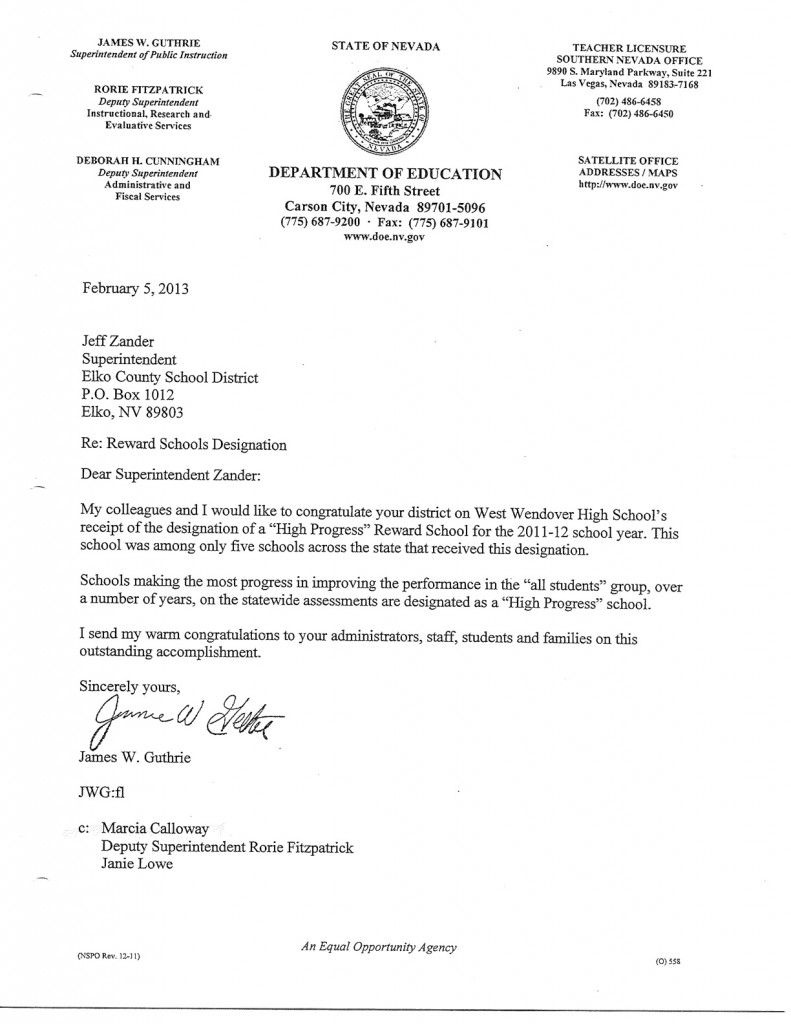 West Wendover Jr/Sr High School received special recognition this month from the Nevada Department of Education as just one of five schools and the only high school to show “High Progress” in academic achievement tests over the past five years.
West Wendover Jr/Sr High School received special recognition this month from the Nevada Department of Education as just one of five schools and the only high school to show “High Progress” in academic achievement tests over the past five years.
“We have a steady effort to improve,” said WWHS Principal Craig Kyllonen. “It has bee a real team effort with teachers, staff, parents and of course students.”
 West Wendover is a ‘Title 1’ school.
West Wendover is a ‘Title 1’ school.
Title 1 is the nation’s oldest and largest federally funded program, according to the U.S. Department of Education. Annually, it provides over $14 billion to school systems across the country for students at risk of failure and living at or near poverty. In fact, over the course of the 2009-2010 school year, federal funding through this program was used by over 56,000 public schools nationwide in order for struggling students to meet state standards in a variety of subject areas.
[media id=2 width=320 height=240]
Originally, the idea of Title 1 was enacted in 1965 under the Elementary and Secondary Education Act. This policy committed to closing the achievement gap between low-income students and other students. The policy was rewritten in 1994 to improve fundamental goals of helping at-risk students. With the implementation of No Child Left Behind, schools must make adequate yearly progress on state testing and focus on best teaching practices in order to continue receiving funds.
 For its first ten years of operation WWHS was almost constantly on academic probation as a ‘school in need of improvement’ and considered it good news to make just enough progress on academic achievement test scores to avoid being taken over by the state, sometimes by the skin of its collective teeth.
For its first ten years of operation WWHS was almost constantly on academic probation as a ‘school in need of improvement’ and considered it good news to make just enough progress on academic achievement test scores to avoid being taken over by the state, sometimes by the skin of its collective teeth.
When a Title I school fails to meet adequate yearly progress (AYP) goals for two or more consecutive years, parents of children in that school have the choice to transfer their children to schools which are (1) not identified as “in need of improvement” and (2) not identified by the state as persistently dangerous schools. However, if all public schools served by the district are classified as schools “in need of improvement,” the district should try to establish a cooperative agreement with other districts in order to provide school choice. Regardless of whether all schools in a district are classified as “in need of improvement,” districts may establish cooperative agreements with one another. The school district must pay for, or provide, transportation to the new school. Public school choice must be provided to eligible students unless prohibited by state law; a district cannot deny school choice to eligible students due to lack of capacity. Finally, the law requires that priority in school choice be given to low-achieving children from low-income families.
 That changed in 2006 when WWHS received the much coveted accreditation from both federal and state departments of education and was also being singled out by the Nevada School Superintendent as a school “that made significant growth in student achievement” for the entire country.
That changed in 2006 when WWHS received the much coveted accreditation from both federal and state departments of education and was also being singled out by the Nevada School Superintendent as a school “that made significant growth in student achievement” for the entire country.
The most recent honor reflects the schools performance over the last five year Kyllonen explained.
“In the past five years, test scores have improved and our growth is one of the highest in the state,” he said.
Earning the distinction however is not enough for the principal.
“We have to continue to push,” he said. “This is a constant effort and every year has its own challenges.”

